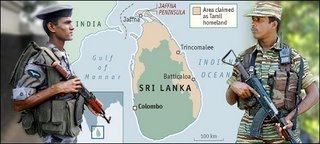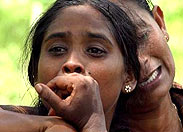Staggering Back Towards War

The Economist
April 26, 2006
A suicide bomb attack against Sri Lanka’s army chief and retaliatory air strikes against rebels have killed several people and heightened fears of renewed war. A formal ceasefire between Tamil separatists and the government had already been looking ragged. It now looks all but broken. Some reports suggest tens of thousands of people are fleeing into the jungle to avoid more attacks in the north of the country
IT WAS exactly the news that Nordic peace monitors, and ordinary Sri Lankans, were dreading. On Tuesday April 25th, a suicide bomber struck the army’s heavily-fortified headquarters in the capital, Colombo. She was a member of the Liberation Tigers of Tamil Eelam, a militant movement that seeks an independent state for the mainly Hindu Tamils of the north and east. The explosion wounded the country’s hawkish army chief, Sarath Fonseka, injured many others and killed a number of his bodyguards. It was the latest in a string of tit-for-tat murders over the past few months that have placed strain on a ceasefire deal signed in 2002.
Tuesday’s attack was probably the final straw for the government, whose retaliation was swift. The same day, and again on Wednesday, airforce planes supported by naval artillery pulverised rebel positions near the northern port of Trincomalee. On Wednesday a local leader said the retaliatory bombing had forced tens of thousands of people to flee towards the relative safety of the jungle. At least 12 civilians were reported killed. The strikes have been called the first “official” military action since 2002, and some say there is great pressure on the government to restart the war. But the government denies breaking the ceasefire and says steps must be taken to prevent further Tiger attacks.
Much of the latest violence has taken place in the multi-ethnic east of the island, a region claimed by the Tigers but dominated by the mainly Buddhist Sinhalese majority. Communal tensions there have worsened in the past few weeks, following a spate of landmine blasts against Sri Lankan soldiers and revenge attacks by Sinhalese mobs on Tamil villagers. These have left more than 100 people dead, many of them soldiers.
It all puts pressure on the Norwegian-brokered ceasefire. After the devastating tsunami in December 2004 some dared hope that the government and rebels might try co-operating, as happened after the wave struck a separatist province in Indonesia. Instead, Sri Lanka’s antagonists soon fell out over the distribution of a id money. The Tigers apparently used the lull after the tsunami to rearm and regroup. Last August they struck in the most provocative way by shooting dead the foreign minister, Lakshman Kadirgamar, an ethnic Tamil reviled by nationalists as a traitor, in his garden.
id money. The Tigers apparently used the lull after the tsunami to rearm and regroup. Last August they struck in the most provocative way by shooting dead the foreign minister, Lakshman Kadirgamar, an ethnic Tamil reviled by nationalists as a traitor, in his garden.
The truce has since been unravelling. An election in November that was boycotted by the Tigers produced a hardline Sinhalese president, Mahinda Rajapakse. His main coalition partners, a Buddhist party led by monks and a Sinhalese chauvinist group with Marxist views, want the ceasefire redrafted or scrapped. They also want Norway dropped as a peacebroker.
Increasingly the government and rebels have been waging a shadow war. This week’s events continue on from earlier violence. An agreement in February to shore up the truce was broken as soon as the ink had dried. The government said the Tigers had attacked its soldiers. The rebels said the army encouraged paramilitaries, led by a renegade Tiger commander, to attack its forces in the east. More negotiations are proposed, but every excuse is used to block them. Bickering over a meeting between eastern-based rebels and the Tiger leadership in the north put paid to peace talks this month.
But not yet doomed to fight?
The Tigers, for their part, have threatened retaliation if the air strikes continue. Some of them think the government plans a large military offensive to take full control of the east. That would, say some in Colombo, leave the government in an advantageous position of strength for future talks. Yet even such thinking keeps alive the idea of some sort of peace.
Any hope that war may yet be postponed rests on the fact that each side seems to be trying hard to pose as a victim, not an aggressor. Mr Rajapakse, though pushed by his hardline coalition partners to keep military pressure on the Tigers, does not want to be abandoned by the outside world. Nor do the Tamils want to be seen as the main stumbling block to peace. As the earlier war dragged on from the 1983 until 2002, many outsiders threw up their hands, leaving investors, donors and tourists to go elsewhere. Rather than be left to butcher each other this time around, the sides may yet see advantage in letting limited violence continue without lurching into full-scale battles.
Copyright © 2006 The Economist Newspaper and The Economist Group. All rights reserved.
April 26, 2006
A suicide bomb attack against Sri Lanka’s army chief and retaliatory air strikes against rebels have killed several people and heightened fears of renewed war. A formal ceasefire between Tamil separatists and the government had already been looking ragged. It now looks all but broken. Some reports suggest tens of thousands of people are fleeing into the jungle to avoid more attacks in the north of the country
IT WAS exactly the news that Nordic peace monitors, and ordinary Sri Lankans, were dreading. On Tuesday April 25th, a suicide bomber struck the army’s heavily-fortified headquarters in the capital, Colombo. She was a member of the Liberation Tigers of Tamil Eelam, a militant movement that seeks an independent state for the mainly Hindu Tamils of the north and east. The explosion wounded the country’s hawkish army chief, Sarath Fonseka, injured many others and killed a number of his bodyguards. It was the latest in a string of tit-for-tat murders over the past few months that have placed strain on a ceasefire deal signed in 2002.
Tuesday’s attack was probably the final straw for the government, whose retaliation was swift. The same day, and again on Wednesday, airforce planes supported by naval artillery pulverised rebel positions near the northern port of Trincomalee. On Wednesday a local leader said the retaliatory bombing had forced tens of thousands of people to flee towards the relative safety of the jungle. At least 12 civilians were reported killed. The strikes have been called the first “official” military action since 2002, and some say there is great pressure on the government to restart the war. But the government denies breaking the ceasefire and says steps must be taken to prevent further Tiger attacks.
Much of the latest violence has taken place in the multi-ethnic east of the island, a region claimed by the Tigers but dominated by the mainly Buddhist Sinhalese majority. Communal tensions there have worsened in the past few weeks, following a spate of landmine blasts against Sri Lankan soldiers and revenge attacks by Sinhalese mobs on Tamil villagers. These have left more than 100 people dead, many of them soldiers.
It all puts pressure on the Norwegian-brokered ceasefire. After the devastating tsunami in December 2004 some dared hope that the government and rebels might try co-operating, as happened after the wave struck a separatist province in Indonesia. Instead, Sri Lanka’s antagonists soon fell out over the distribution of a
 id money. The Tigers apparently used the lull after the tsunami to rearm and regroup. Last August they struck in the most provocative way by shooting dead the foreign minister, Lakshman Kadirgamar, an ethnic Tamil reviled by nationalists as a traitor, in his garden.
id money. The Tigers apparently used the lull after the tsunami to rearm and regroup. Last August they struck in the most provocative way by shooting dead the foreign minister, Lakshman Kadirgamar, an ethnic Tamil reviled by nationalists as a traitor, in his garden.The truce has since been unravelling. An election in November that was boycotted by the Tigers produced a hardline Sinhalese president, Mahinda Rajapakse. His main coalition partners, a Buddhist party led by monks and a Sinhalese chauvinist group with Marxist views, want the ceasefire redrafted or scrapped. They also want Norway dropped as a peacebroker.
Increasingly the government and rebels have been waging a shadow war. This week’s events continue on from earlier violence. An agreement in February to shore up the truce was broken as soon as the ink had dried. The government said the Tigers had attacked its soldiers. The rebels said the army encouraged paramilitaries, led by a renegade Tiger commander, to attack its forces in the east. More negotiations are proposed, but every excuse is used to block them. Bickering over a meeting between eastern-based rebels and the Tiger leadership in the north put paid to peace talks this month.
But not yet doomed to fight?
The Tigers, for their part, have threatened retaliation if the air strikes continue. Some of them think the government plans a large military offensive to take full control of the east. That would, say some in Colombo, leave the government in an advantageous position of strength for future talks. Yet even such thinking keeps alive the idea of some sort of peace.
Any hope that war may yet be postponed rests on the fact that each side seems to be trying hard to pose as a victim, not an aggressor. Mr Rajapakse, though pushed by his hardline coalition partners to keep military pressure on the Tigers, does not want to be abandoned by the outside world. Nor do the Tamils want to be seen as the main stumbling block to peace. As the earlier war dragged on from the 1983 until 2002, many outsiders threw up their hands, leaving investors, donors and tourists to go elsewhere. Rather than be left to butcher each other this time around, the sides may yet see advantage in letting limited violence continue without lurching into full-scale battles.
Copyright © 2006 The Economist Newspaper and The Economist Group. All rights reserved.

0 Comments:
Post a Comment
<< Home